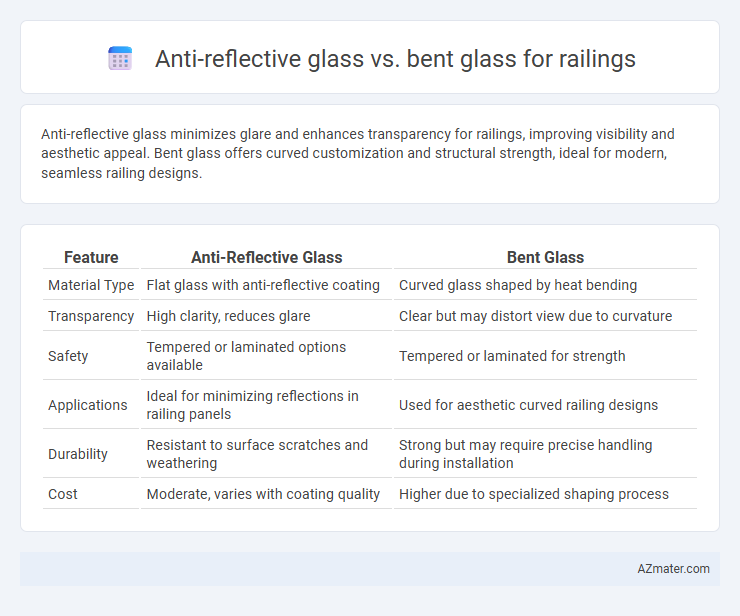Anti-reflective glass minimizes glare and enhances transparency for railings, improving visibility and aesthetic appeal. Bent glass offers curved customization and structural strength, ideal for modern, seamless railing designs.
Table of Comparison
| Feature | Anti-Reflective Glass | Bent Glass |
|---|---|---|
| Material Type | Flat glass with anti-reflective coating | Curved glass shaped by heat bending |
| Transparency | High clarity, reduces glare | Clear but may distort view due to curvature |
| Safety | Tempered or laminated options available | Tempered or laminated for strength |
| Applications | Ideal for minimizing reflections in railing panels | Used for aesthetic curved railing designs |
| Durability | Resistant to surface scratches and weathering | Strong but may require precise handling during installation |
| Cost | Moderate, varies with coating quality | Higher due to specialized shaping process |
Introduction to Glass Options for Railings
Anti-reflective glass enhances visibility and safety in railings by minimizing glare and reflections, making it ideal for clear, unobstructed views in architectural designs. Bent glass offers strength and aesthetic appeal through its curved form, providing seamless, elegant railing solutions that conform to custom shapes and spaces. Choosing between anti-reflective and bent glass depends on design priorities such as clarity, durability, and the architectural style of the railing installation.
What is Anti-Reflective Glass?
Anti-reflective glass is specially coated to minimize glare and reflections, enhancing visibility and safety in railing applications. This glass type uses thin-film coatings that reduce surface reflections by up to 99%, improving transparency and aesthetic appeal. Compared to bent glass, anti-reflective glass offers clearer views and a sleeker look, making it ideal for modern railing systems where unobstructed sightlines are essential.
What is Bent Glass?
Bent glass is a type of glass that has been heated and shaped into curved forms to fit specific architectural designs, commonly used for railings to provide sleek, smooth contours without visible joints. Unlike anti-reflective glass, which is designed with chemical coatings to reduce glare and enhance transparency, bent glass emphasizes structural flexibility and aesthetic appeal through its molded shapes. This glass type offers strength and durability while allowing for custom curvature that complements modern railing installations.
Visual Appeal: Transparency vs. Curved Design
Anti-reflective glass enhances railing visual appeal by maximizing transparency and reducing glare, ensuring clear, unobstructed views ideal for modern, minimalist aesthetics. Bent glass offers a striking curved design that adds dynamic architectural interest and smooth contours, creating a sculptural effect while maintaining structural integrity. The choice between transparency of anti-reflective glass and the bold form of bent glass depends on whether seamless visibility or artistic curvature is prioritized in the railing design.
Light Transmission and Glare Reduction
Anti-reflective glass for railings offers superior light transmission by minimizing surface reflections, resulting in clearer and brighter views compared to bent glass. Bent glass, while structurally advantageous for curved installations, tends to produce more glare due to its reflective properties and surface curvature. Choosing anti-reflective glass enhances visibility and reduces eye strain by effectively diminishing glare without compromising on safety or architectural aesthetics.
Safety and Durability: Comparing the Two
Anti-reflective glass enhances safety by reducing glare, improving visibility, and minimizing accidental collisions on railings, while bent glass offers superior strength due to its curved form, increasing impact resistance and load-bearing capacity. Durability-wise, bent glass withstands temperature fluctuations and mechanical stress better than flat anti-reflective glass, making it ideal for outdoor railings exposed to harsh weather. Choosing between the two depends on prioritizing visual clarity and user safety against structural resilience and longevity in railing applications.
Maintenance Requirements
Anti-reflective glass for railing requires minimal maintenance due to its special coating that reduces fingerprints, smudges, and glare, allowing for easier cleaning and prolonged clarity. Bent glass, while aesthetically pleasing and structurally robust, may demand more frequent cleaning and inspections to maintain its curved surface integrity and prevent accumulation of dirt in the bends. Regular maintenance protocols for both materials should include gentle cleaning with non-abrasive products and routine checks for any damages to ensure longevity and safety of the railing system.
Customization and Design Flexibility
Anti-reflective glass offers superior clarity and minimal glare, allowing for highly customized railing designs that emphasize unobstructed views and sleek aesthetics. Bent glass provides enhanced design flexibility through its ability to form curved and complex shapes, enabling creative and unique railing profiles tailored to specific architectural requirements. Both materials support custom fabrication options, but bent glass excels in delivering dynamic, fluid forms while anti-reflective glass prioritizes visual transparency and minimal distortion.
Cost Considerations
Anti-reflective glass for railing typically involves higher production costs due to specialized coating processes that reduce glare and enhance transparency, making it a premium choice. Bent glass, shaped through heat bending techniques, often incurs added expenses related to fabrication and custom fitting but generally costs less than high-end anti-reflective treatments. Budget planning for railing installations should consider the balance between optical clarity benefits of anti-reflective glass and the structural customization provided by bent glass within the project's financial constraints.
Which Glass is Best for Your Railing Project?
Anti-reflective glass offers enhanced clarity and minimal glare, making it ideal for railing projects where unobstructed views and aesthetics are priorities. Bent glass provides structural strength and unique curved designs, suitable for custom railings that require both durability and style. Choosing the best glass depends on whether visual transparency or architectural form is more critical to your railing project's goals.

Infographic: Anti-reflective glass vs Bent glass for Railing
 azmater.com
azmater.com